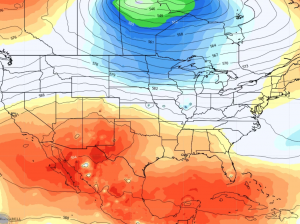In addition to its magnitude, which will be dangerous for some, the heat will be notable for its longevity. Phoenix, for example, has already logged 10 days in a row at or above 110 degrees — the seventh-longest streak on record — and the forecast calls for highs in the 111-to-117-degree range until further notice. That could catapult the heat-prone city into its longest ever streak above that level.
The heat will be dry yet punishing in the Southeast, while the south-central U.S. and southern Plains will contend with humidity drawn in from the Gulf of Mexico. That will overlap with the hot temperatures to push heat indexes — measures of how hot it feels, taking into account temperature and humidity — into hazardous territory.
What’s happening right now?
- A heat dome — or a ridge of high pressure bringing hot, dry, sinking air — is growing in size over New Mexico. In the coming days, it will reach from California and Mexico’s Baja Peninsula to the Deep South. That will force the jet stream, and any cooler or inclement weather, across Canada or the northern United States. Across the southern and central states, temperatures will bake.
- That heat dome will intensify into the weekend, with temperatures increasing each day.
- “Extreme heat will significantly increase the potential for heat related illnesses, particularly for those working or participating in outdoor activities,” warned the National Weather Service in Las Vegas. It also noted that river valleys — where most people venture for hiking, water sports or other outdoor recreation — are usually the hottest.
- The heat scorching the Lower 48 is occurring amid the hottest weather ever reported on the planet. On Monday morning, the World Meteorological Organization declared that last week was the planet’s hottest on record, according to preliminary data.
- In the Southwest, the hottest temperatures will be found in California, Arizona and New Mexico. California’s Death Valley is forecast to hit 127 degrees on Sunday, coming after a week of highs steadily climbing from the upper 110s through the 120s. It’s possible the furnace-like valley could flirt with 130 degrees. If that happens, it would be among the highest temperatures ever reliably measured on the planet. Phoenix is predicted to hover in the 110s, with overnight lows failing to drop below 90. By late week, the extreme heat will spread into the San Joaquin Valley and Mojave Desert, with highs of 105 to 115 degrees possible. The hot, dry weather is also fueling fires, with 11 large blazes burning in New Mexico and Arizona.
- In Texas, the heat will overlap with sultry, steamy humidity. While actual air temperatures may not break records, with most of the Lone Star State sitting around 100 degrees, the humid conditions will exacerbate heat risk. Heat indexes of 105 to 110 degrees are expected much of the week in cities like Dallas, San Antonio, Waco, Austin and Houston, while far South Texas could see heat indexes closer to 115 degrees.
- For Florida, highs in the 90s and excessive humidity will again spike heat indexes well into the triple digits. Miami has seen a heat index of 104 degrees each of the past seven days, and that streak could continue. The heat index has made it to 100 degrees or higher every day for the past four weeks. There appears to be no end in sight, with hot, dry air from the Sahara yielding clear skies overhead and allowing sunshine to pour down. Moreover, extremely hot water temperatures in the lower to mid-90s off the Southwest Florida coastline are adding copious moisture into the air.
Why this heat wave is dangerous
- In the Southwest, the heat is dangerous because it can dehydrate people. With bone-dry relative humidity, any sweat will evaporate before it can gather on someone’s skin. That means that, by the time someone realizes they’re dehydrated, it may be too late. That’s why it’s easy to fall victim to a “dry heat.”
- For Texas and the Southeast, meanwhile, heavy humidity will prevent sweat from evaporating into the air, meaning we lose the cooling effect of that evaporation (that’s the whole reason mammals sweat). Without that mechanism, people outside won’t be able to naturally cool themselves, leading to a greater heat stress on the body.
- In many areas, overnight lows won’t dip below the mid-80s. While cooling shelters are often open during the daytime, comparatively few are available to residents 24 hours a day. Warm overnight lows can be especially dangerous to the elderly and other vulnerable populations, since it prevents the body from achieving a natural nocturnal cool-down period.
- The prolonged nature of the heat will compound vulnerability, particularly for those who work or live outside or struggle to afford the electricity costs of cooling.
What to know about heat waves
- Extreme heat kills more people than any other weather hazard in the United States. We’re monitoring dangerous heat waves across the country — you can look up the heat risk in your area with our tracker.
- Heat domes, which create sprawling zones of strong high pressure, are a key component of heat waves. Here’s a look at the science of heat domes and how they work.
- The intensity and longevity of heat domes is growing as human-induced climate change tips the scales toward more extreme events.
Source: www.washingtonpost.com









 Nearly 50 million Americans are set to face triple-digit temperature this week amid a sprawling dome of heat that will engulf most of the southern United States. Heat advisories are in effect in Florida, Texas and New Mexico, while excessive heat watches and warnings blanket much of Arizona, Southern California and Nevada.
Nearly 50 million Americans are set to face triple-digit temperature this week amid a sprawling dome of heat that will engulf most of the southern United States. Heat advisories are in effect in Florida, Texas and New Mexico, while excessive heat watches and warnings blanket much of Arizona, Southern California and Nevada.


